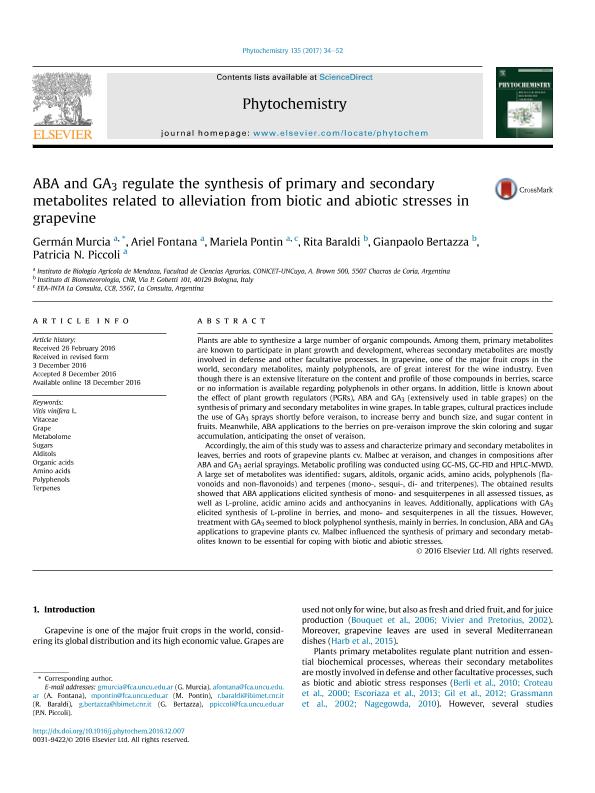Mostrar el registro sencillo del ítem
dc.contributor.author
Murcia, Mauro Germán

dc.contributor.author
Fontana, Ariel Ramón

dc.contributor.author
Pontin, Mariela Ana

dc.contributor.author
Baraldi, Rita
dc.contributor.author
Bertazza, Gianpaolo
dc.contributor.author
Piccoli, Patricia Noemí

dc.date.available
2018-03-26T20:36:36Z
dc.date.issued
2017-03
dc.identifier.citation
Murcia, Mauro Germán; Fontana, Ariel Ramón; Pontin, Mariela Ana; Baraldi, Rita; Bertazza, Gianpaolo; et al.; ABA and GA3 regulate the synthesis of primary and secondary metabolites related to alleviation from biotic and abiotic stresses in grapevine; Pergamon-Elsevier Science Ltd; Phytochemistry; 135; 3-2017; 34-52
dc.identifier.issn
0031-9422
dc.identifier.uri
http://hdl.handle.net/11336/40044
dc.description.abstract
Plants are able to synthesize a large number of organic compounds. Among them, primary metabolites are known to participate in plant growth and development, whereas secondary metabolites are mostly involved in defense and other facultative processes. In grapevine, one of the major fruit crops in the world, secondary metabolites, mainly polyphenols, are of great interest for the wine industry. Even though there is an extensive literature on the content and profile of those compounds in berries, scarce or no information is available regarding polyphenols in other organs. In addition, little is known about the effect of plant growth regulators (PGRs), ABA and GA3 (extensively used in table grapes) on the synthesis of primary and secondary metabolites in wine grapes. In table grapes, cultural practices include the use of GA3 sprays shortly before veraison, to increase berry and bunch size, and sugar content in fruits. Meanwhile, ABA applications to the berries on pre-veraison improve the skin coloring and sugar accumulation, anticipating the onset of veraison. Accordingly, the aim of this study was to assess and characterize primary and secondary metabolites in leaves, berries and roots of grapevine plants cv. Malbec at veraison, and changes in compositions after ABA and GA3 aerial sprayings. Metabolic profiling was conducted using GC-MS, GC-FID and HPLC-MWD. A large set of metabolites was identified: sugars, alditols, organic acids, amino acids, polyphenols (flavonoids and non-flavonoids) and terpenes (mono-, sesqui-, di- and triterpenes). The obtained results showed that ABA applications elicited synthesis of mono- and sesquiterpenes in all assessed tissues, as well as L-proline, acidic amino acids and anthocyanins in leaves. Additionally, applications with GA3 elicited synthesis of L-proline in berries, and mono- and sesquiterpenes in all the tissues. However, treatment with GA3 seemed to block polyphenol synthesis, mainly in berries. In conclusion, ABA and GA3 applications to grapevine plants cv. Malbec influenced the synthesis of primary and secondary metabolites known to be essential for coping with biotic and abiotic stresses.
dc.format
application/pdf
dc.language.iso
eng
dc.publisher
Pergamon-Elsevier Science Ltd

dc.rights
info:eu-repo/semantics/openAccess
dc.rights.uri
https://creativecommons.org/licenses/by-nc-sa/2.5/ar/
dc.subject
Alditols
dc.subject
Amino Acids
dc.subject
Grape
dc.subject
Metabolome
dc.subject
Organic Acids
dc.subject
Polyphenols
dc.subject
Sugars
dc.subject
Terpenes
dc.subject
Vitaceae
dc.subject
Vitis Vinifera L.
dc.subject.classification
Otras Ciencias Biológicas

dc.subject.classification
Ciencias Biológicas

dc.subject.classification
CIENCIAS NATURALES Y EXACTAS

dc.title
ABA and GA3 regulate the synthesis of primary and secondary metabolites related to alleviation from biotic and abiotic stresses in grapevine
dc.type
info:eu-repo/semantics/article
dc.type
info:ar-repo/semantics/artículo
dc.type
info:eu-repo/semantics/publishedVersion
dc.date.updated
2018-03-23T18:19:11Z
dc.journal.volume
135
dc.journal.pagination
34-52
dc.journal.pais
Estados Unidos

dc.description.fil
Fil: Murcia, Mauro Germán. Consejo Nacional de Investigaciones Científicas y Técnicas. Centro Científico Tecnológico Conicet - Mendoza. Instituto de Biología Agrícola de Mendoza. Universidad Nacional de Cuyo. Facultad de Ciencias Agrarias. Instituto de Biología Agrícola de Mendoza; Argentina
dc.description.fil
Fil: Fontana, Ariel Ramón. Consejo Nacional de Investigaciones Científicas y Técnicas. Centro Científico Tecnológico Conicet - Mendoza. Instituto de Biología Agrícola de Mendoza. Universidad Nacional de Cuyo. Facultad de Ciencias Agrarias. Instituto de Biología Agrícola de Mendoza; Argentina
dc.description.fil
Fil: Pontin, Mariela Ana. Instituto Nacional de Tecnología Agropecuaria. Centro Regional Mendoza-San Juan. Estación Experimental Agropecuaria La Consulta; Argentina. Consejo Nacional de Investigaciones Científicas y Técnicas. Centro Científico Tecnológico Conicet - Mendoza. Instituto de Biología Agrícola de Mendoza. Universidad Nacional de Cuyo. Facultad de Ciencias Agrarias. Instituto de Biología Agrícola de Mendoza; Argentina
dc.description.fil
Fil: Baraldi, Rita. Consejo Nacional de Investigaciones Científicas y Técnicas. Centro Científico Tecnológico Conicet - Mendoza. Instituto de Biología Agrícola de Mendoza. Universidad Nacional de Cuyo. Facultad de Ciencias Agrarias. Instituto de Biología Agrícola de Mendoza; Argentina
dc.description.fil
Fil: Bertazza, Gianpaolo. Consiglio Nazionale delle Ricerche. Instituto di Biometeorologia; Italia
dc.description.fil
Fil: Piccoli, Patricia Noemí. Consejo Nacional de Investigaciones Científicas y Técnicas. Centro Científico Tecnológico Conicet - Mendoza. Instituto de Biología Agrícola de Mendoza. Universidad Nacional de Cuyo. Facultad de Ciencias Agrarias. Instituto de Biología Agrícola de Mendoza; Argentina
dc.journal.title
Phytochemistry

dc.relation.alternativeid
info:eu-repo/semantics/altIdentifier/doi/http://dx.doi.org/10.1016/j.phytochem.2016.12.007
dc.relation.alternativeid
info:eu-repo/semantics/altIdentifier/url/https://www.sciencedirect.com/science/article/pii/S0031942216302734
Archivos asociados
